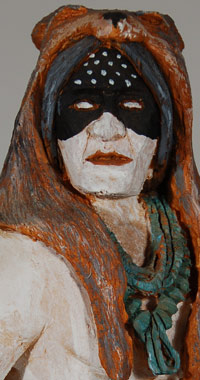Navajo (Diné) Folk Art Wood Carving “Skinwalker” [SOLD]
+ Add to my watchlist Forward to Friend
- Category: Other Items
- Origin: Diné of the Navajo Nation
- Medium: wood, pigments
- Size: 15-1/2” sculpture; 19-1/2” with pedestal
- Item # C3347L SOLD
Lawrence Jacquez (pronounced Hackus) was born in 1965 and lived in a hogan under the shadow of Dzil Ná'oodilii. There is an old cedar hogan weathering away near the top of the mountain according to Jacques. He says "I believe that First Man and First Woman may have lived there." According to Navajo origin legend, First Man and First Woman were the first beings to appear as humans; they formed the four mountains sacred to the Navajos from soil gathered from mountains in the prior world.
This strong belief in Navajo legends is probably the driving force for sculptures by Jacquez. He is known to have carved and painted extraordinary objects accurately depicting the Yeis, Navajo mythology, and the dances and escapades of skinwalkers. The Rosenaks stated that they were surprised by the appearance of skinwalkers in his work, and doubtful of their very existence, but Jacquez told them that "evil witches do exist" and they do appear on Dzil Ná'oodilii.
 The Navajo legend of skinwalkers:
The Navajo legend of skinwalkers:
"The Navajo skinwalker legend is one of the more complex and terrifying stories, steeped in mystery and evil intent. Many Navajos believe firmly in the existence of skinwalkers and refuse to discuss them publicly for fear of retribution. They believe skinwalkers walk freely among the tribe and secretly transform under the cover of night.
"The term yee naaldooshii literally translates to "with it, he goes on all fours." According to Navajo legend a skinwalker is a medicine man or which (witch) who has attained the highest level of priesthood in the tribe, but chose to use his or her power for evil by taking the form of an animal to inflict pain and suffering on others.
"To become a skinwalker requires the most evil of deeds, the killing of a close family member. They literally become humans who have acquired immense supernatural power, including the ability to transform into animals and other people.
"According to the Navajo skinwalker legend, these evil witches are typically seen in the form of a coyote, owl, fox, wolf or crow — although they do have the ability to turn into any animal they choose.
"Because it is believed that skinwalkers wear the skins of the animals they transform into, it is considered taboo to wear the pelt of any animal. In fact, the Navajo are only known to wear two hides, sheepskin and buckskin, both of which are only used for ceremonial purposes."
Source: navajolegends.org
This all-wood carving of a skinwalker is in the personage of a very muscular and strong individual with good upper body proportions. He is wearing the skin of a wolf draped over his head and a black mask over his eyes. He has a turquoise necklace around his neck, ketohs on both wrists and rings on most fingers. It appears that buckskin is draped over his front somewhat as a loin cloth. Traditional buckskin moccasins complete his dress.
The carving is exceptional. It clearly illustrates that the artist is well versed in the techniques of wood carving. Every part is proportional and beautifully executed. The painting, although minimal, is the work of a true artist.
Condition: appears to be in original condition. There is one finger on the right hand without turquoise but it is not known if that was original or if the stone has fallen off.
Provenance: from the collection of Jan and Chuck Rosenak. Published in Navajo Folk Art by Chuck and Jan Rosenak. 1994, page 60.
Recommended Reading: Navajo Folk Art by Chuck and Jan Rosenak
- Category: Other Items
- Origin: Diné of the Navajo Nation
- Medium: wood, pigments
- Size: 15-1/2” sculpture; 19-1/2” with pedestal
- Item # C3347L SOLD



